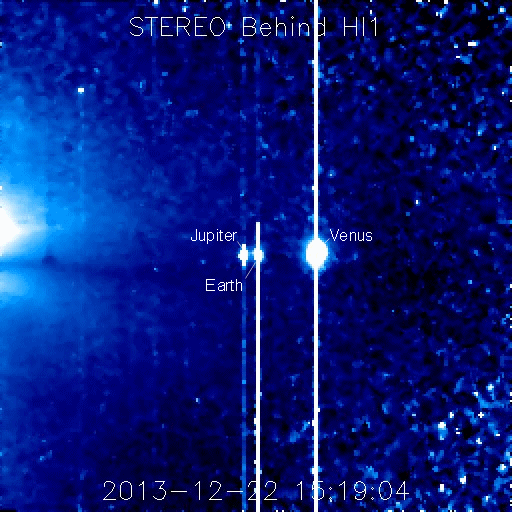CHRISTMAS CONJUNCTION: According to some scholars, the Star of Bethlehem might have been a close encounter between Venus and Jupiter. The two brightest planets in the night sky, merged, would have made a spectacle of Biblical proportions. This Christmas, NASA's STEREO-B probe is observing a conjunction of three planets--Venus, Earth and Jupiter:
Unlike conjunctions of the distant past, this one includes our home planet. STEREO-B is located on the far side of the sun where it can look back and see Earth along with other worlds in the Solar System. Only NASA's twin STEREO probes, equipped with their high dynamic-range Heliospheric Imagers, can witness this kind of conjunction.
From STEREO-B's point of view, Earth and Jupiter are less than 0.5 degrees apart, while all three planets fit in a circle 3 degrees in diameter. This meeting is not nearly as tight as the putative Star of Bethlehem conjunction ~2000 years ago. At that time Venus and Jupiter could have been as little as 6 arcseconds (0.00166 degrees) apart. Nevertheless, the ongoing conjunction is still a beauty. Stay tuned for updates as the three planets converge. SpaceWeather
MERRY CHRISTMAS AND A HAPPY NEW YEAR !!!
...for the darkest hour is just before the dawn and the ushering in of a more enlightened, happier and better times ahead!
 |
| Star of Bethlehem |
TRIVIA: In 1614, German astronomer Johannes Kepler determined that a series of three conjunctions of the planets Jupiter and Saturn occurred in the year 7 BC. Although conjunctions were important in astrology, Kepler was not thinking in astrological terms. He argued (incorrectly) that a planetary conjunction could create a nova, which he linked to the Star of Bethlehem. In the 20th century, Prof. Karlis Kaufmanis, an astronomer, argued that this was an astronomical event where Jupiter and Saturn were in a triple conjunction in the constellation Pisces.
Other writers suggest that the star was a comet. Halley's Comet was visible in 12 BC and another object, possibly a comet or nova, was seen by Chinese and Korean stargazers in about 5 BC. This object was observed for over seventy days with no movement recorded. Ancient writers described comets as "hanging over" specific cities, just as the Star of Bethlehem was said to have "stood over" the "place" where Jesus was (the town of Bethlehem). However, this is generally thought unlikely as in ancient times comets were generally seen as bad omens. - Star of Bethlehem, WIkipedia
MERRY CHRISTMAS AND A HAPPY NEW YEAR !!!
...for the darkest hour is just before the dawn and the ushering in of a more enlightened, happier and better times ahead!


